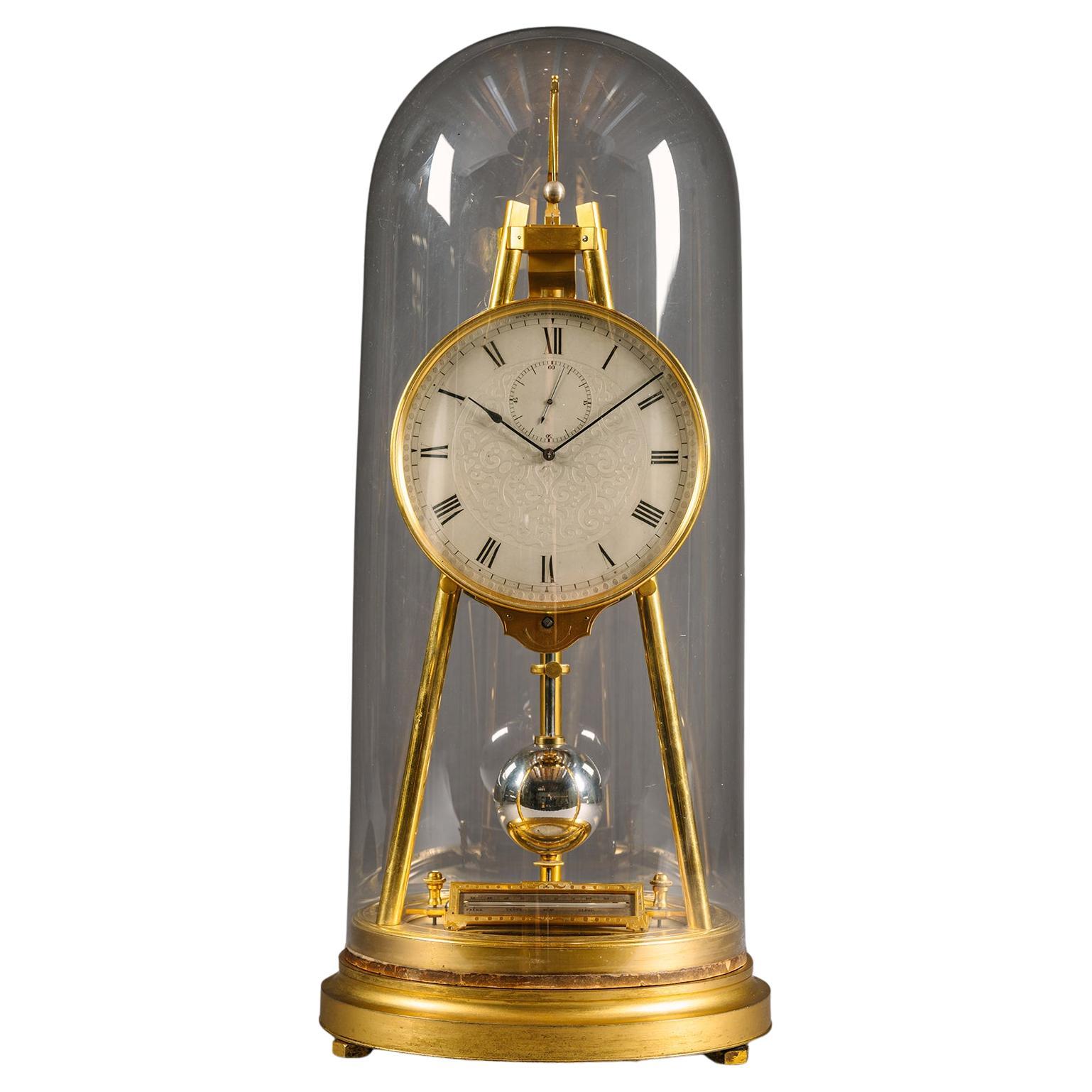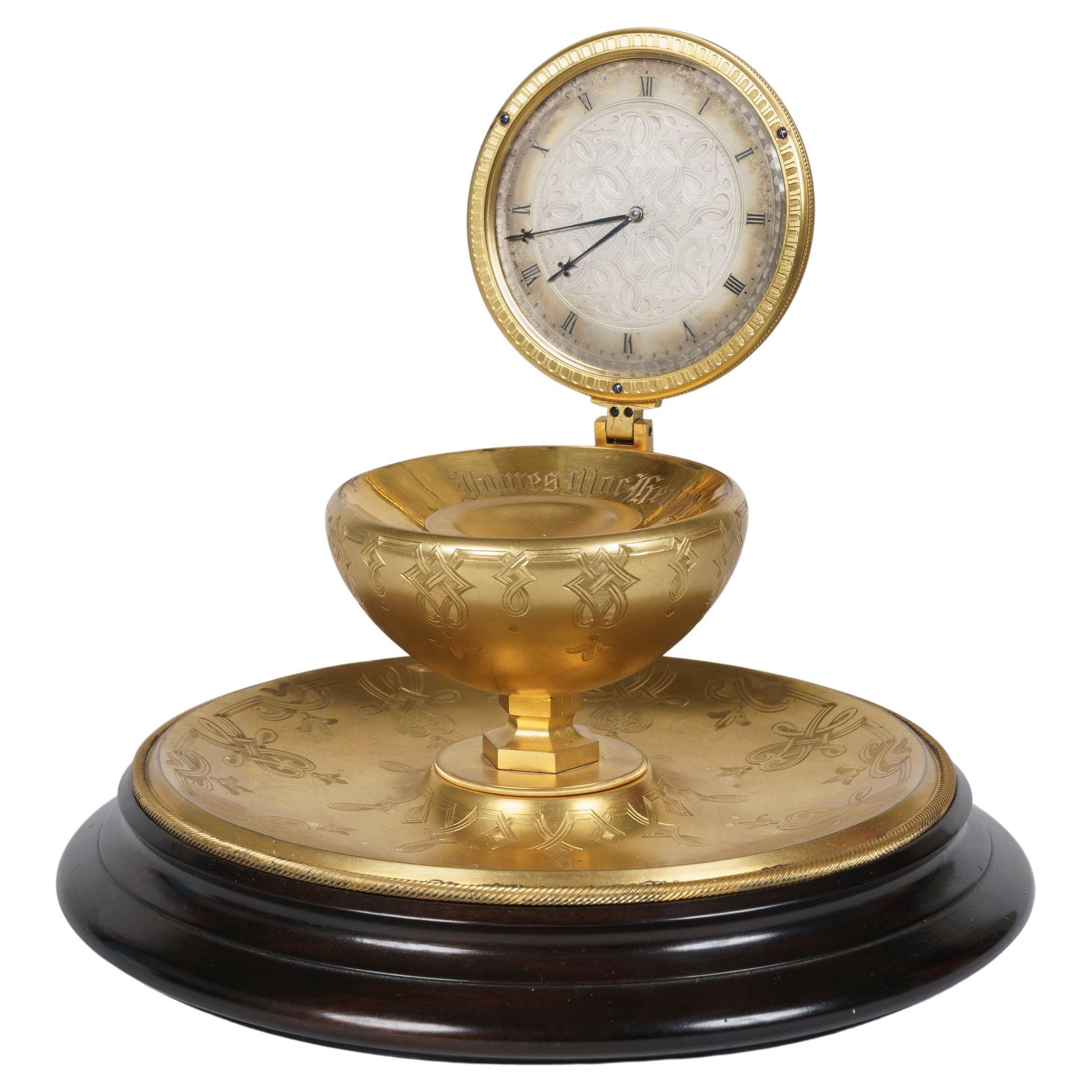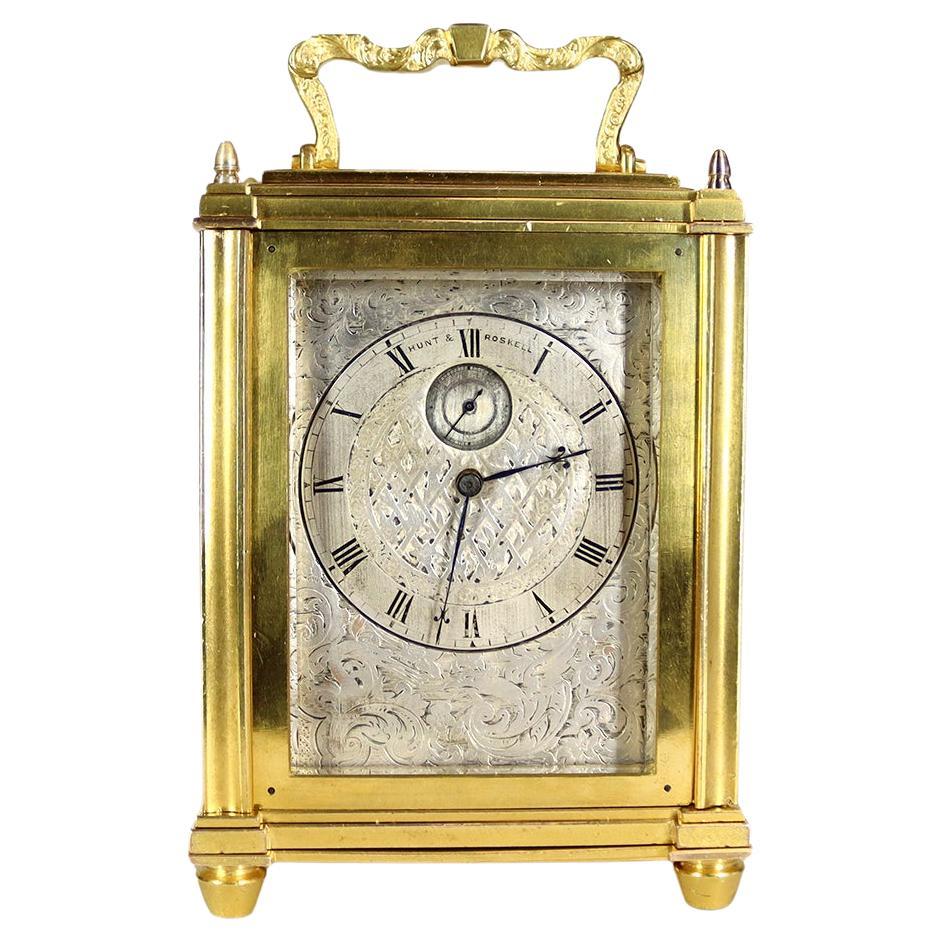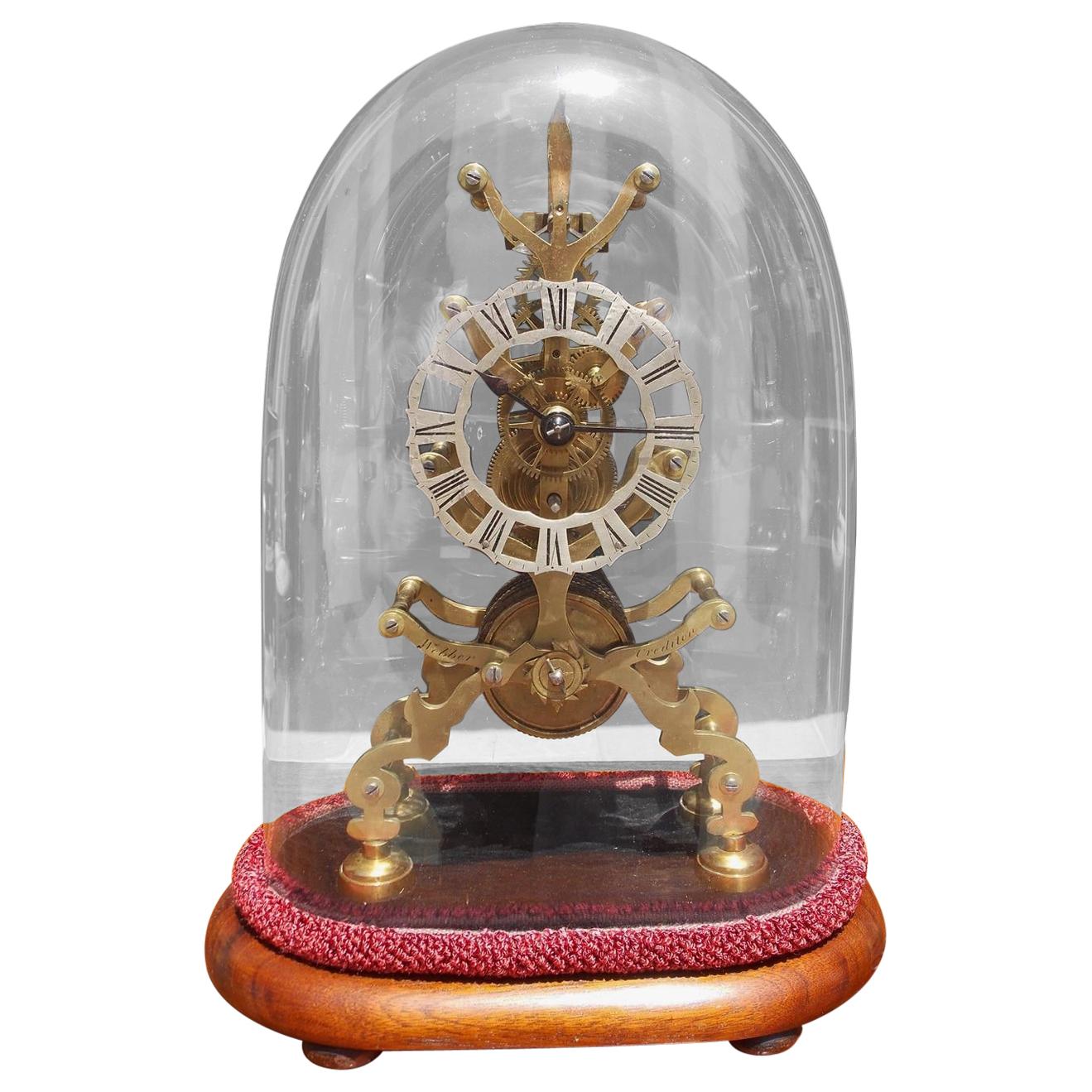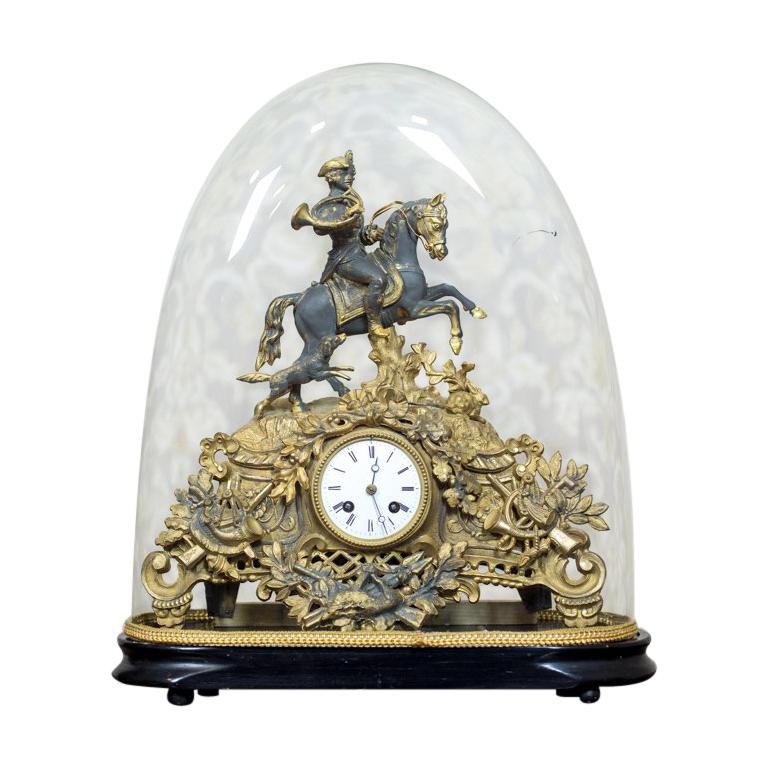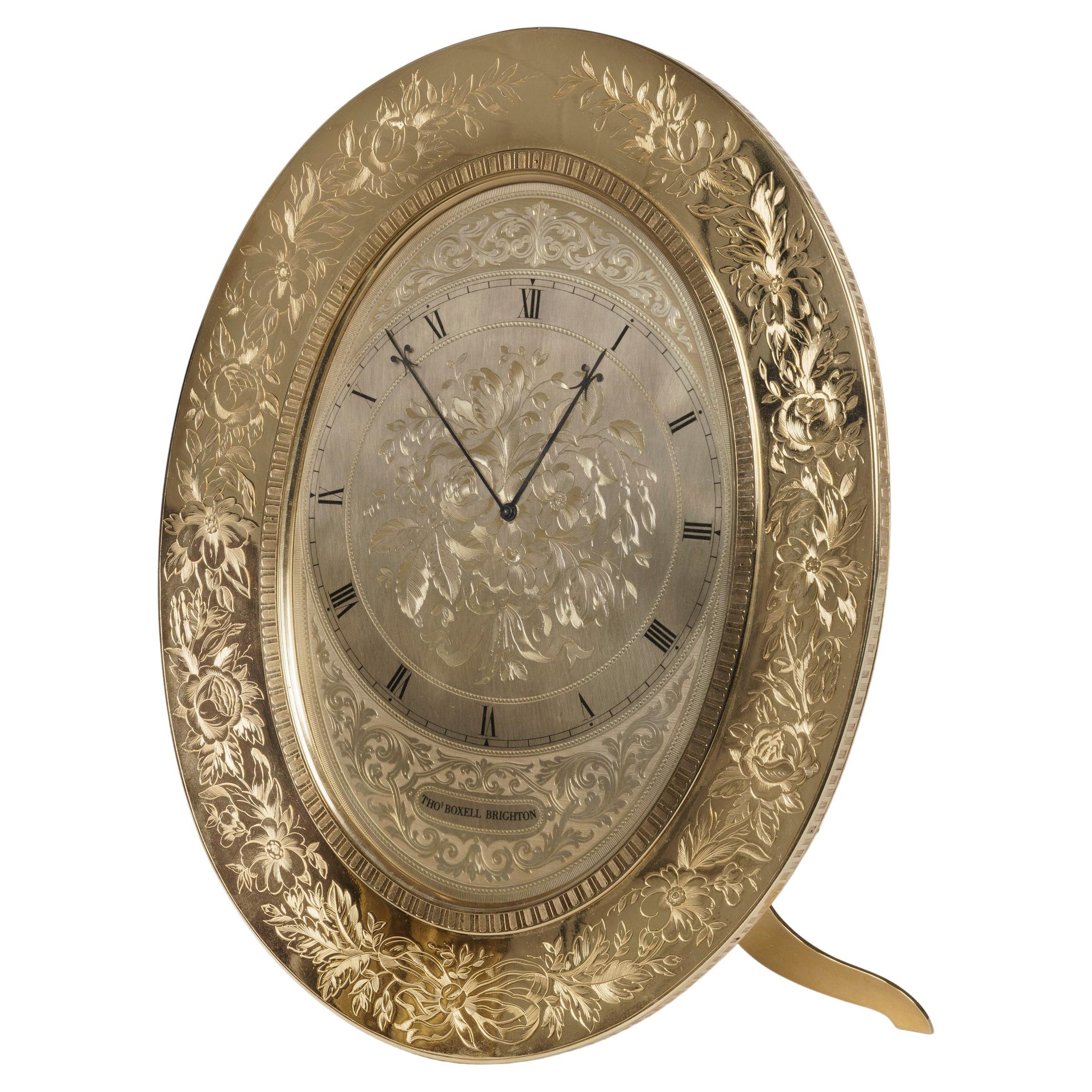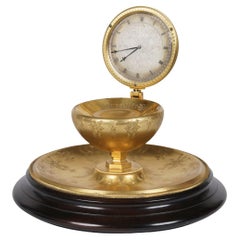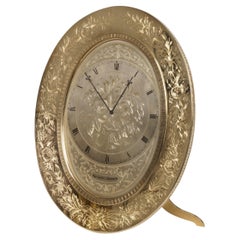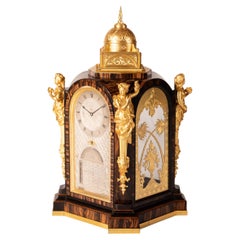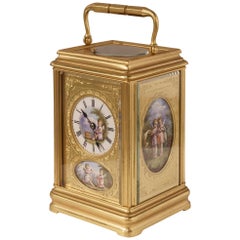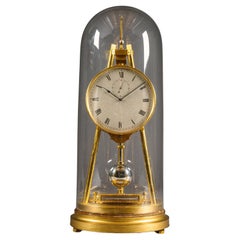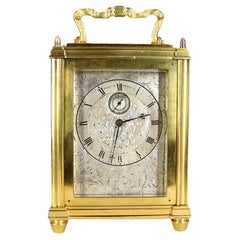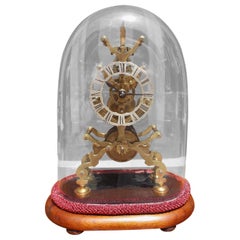Items Similar to Early Tripod Table Clock by Thomas Cole with Glass Dome
Want more images or videos?
Request additional images or videos from the seller
1 of 5
Early Tripod Table Clock by Thomas Cole with Glass Dome
$62,279.85
£45,000
€53,212.65
CA$85,247.41
A$95,481.61
CHF 49,682.26
MX$1,159,617.48
NOK 629,844.78
SEK 594,305.46
DKK 397,042.14
Shipping
Retrieving quote...The 1stDibs Promise:
Authenticity Guarantee,
Money-Back Guarantee,
24-Hour Cancellation
About the Item
An extraordinary rustic tripod table clock
by Thomas Cole
Retailed by E. White of London
The circular green velvet-clad base supporting three equidistantly spaced brass imitation logs, from which the clock and its mechanism are suspended; housed within a brass bezel conformingly styled as naturalistic logs, the circular etched and engraved gilt dial with elegant blued steel hands, marked at 6 o'clock "E. White, 20 Cockspur St, London", having the hours marked in Roman numerals; the tapered two-tier movement has a six wheel train with five-spoke crossings between spotted plates, the upper section fixed by blued steel screws to the backplate, enclosing a Brocot-style deadbeat escapement incorporating rubies and train to the centre wheel, the pendulum of most unusual design styled as a lidded cauldron over a simulated fire. Complete with a glass dome and key. The front plate numbered “1637.”
London made, circa 1861
Thomas Cole, (1800-1864)
Son of Thomas Cole Snr, a Somerset clockmaker, his history and works are fully recorded in 'Thomas Cole & Victorian Clockmaking' by John B. Hawkins, published 1975, in Sydney. Known as a specialist in making decorative timepieces of the highest quality, Cole exhibited at the Great Exhibition at the Crystal Palace in 1851; he warranted an 'honourable mention' in the Paris Exhibition of 1855 and the London 1862 Exposition International, where he was awarded a medal for 'excellence of taste and design'.
Hawkins discuss Thomas Cole's tripod clocks with great detail, estimating that no more than 75 of these were made. With reference to this particular design, the author suggests it may have been exhibited at the 1862 London Exhibition.
Literature:
Hawkins, John B. Thomas Cole & Victorian Clockmaking. Sydney: Macarthur press, 1975, pp.110-111 (item 38), illustrating an example numbered 1642 and dated circa 1861.
- Dimensions:Height: 19 in (48.26 cm)Diameter: 10 in (25.4 cm)
- Materials and Techniques:
- Place of Origin:
- Period:
- Date of Manufacture:circa 1861
- Condition:Wear consistent with age and use. In excellent working condition.
- Seller Location:London, GB
- Reference Number:Seller: 93721stDibs: LU954719361542
About the Seller
5.0
Recognized Seller
These prestigious sellers are industry leaders and represent the highest echelon for item quality and design.
Established in 1964
1stDibs seller since 2012
53 sales on 1stDibs
Typical response time: 9 hours
Associations
The British Antique Dealers' AssociationLAPADA - The Association of Arts & Antiques Dealers
- ShippingRetrieving quote...Shipping from: London, United Kingdom
- Return Policy
Authenticity Guarantee
In the unlikely event there’s an issue with an item’s authenticity, contact us within 1 year for a full refund. DetailsMoney-Back Guarantee
If your item is not as described, is damaged in transit, or does not arrive, contact us within 7 days for a full refund. Details24-Hour Cancellation
You have a 24-hour grace period in which to reconsider your purchase, with no questions asked.Vetted Professional Sellers
Our world-class sellers must adhere to strict standards for service and quality, maintaining the integrity of our listings.Price-Match Guarantee
If you find that a seller listed the same item for a lower price elsewhere, we’ll match it.Trusted Global Delivery
Our best-in-class carrier network provides specialized shipping options worldwide, including custom delivery.More From This Seller
View AllRare 19th Century Brass Engraved 'Inkwell' Table Clock attributed to Thomas Cole
By Thomas Cole (Clockmaker)
Located in London, GB
An Unusual 'Inkwell' Table Clock
Attributed to Thomas Cole
Constructed from gilt brass, the novelty timepiece rising from a turned ebonised base inset with a concave brass tray e...
Category
Antique 19th Century English Table Clocks and Desk Clocks
Materials
Brass, Bronze
Large Gilt Brass Engraved Oval Table Clock by Thomas Cole
By Thomas Cole (Clockmaker)
Located in London, GB
A large oval strut clock
By Thomas Cole
The case constructed from gilt brass and designed to be as thin as possible, finely engraved throughout, of substantial oval size, and supported by means of a fold-out foot, the outer frame with floral engraved border, the silvered dial decorated in conforming manner and denoting the hours in Roman numerals with blued steel hands, its centre decorated in foliate patterns; the movement with four turned pillars, spring barrel, steel balance and lever escapement and signed to the backplate by the retailer, also denoted on the dial's cartouche "Thos Boxell, Brighton," and numbered to the rear.
Circa 1860
Dimensions: H: 11 in / 28 cm
Comparative Literature:
Hawkins, J. B. Thomas Cole & Victorian Clockmaking. Woodbridge: Antique Collectors' Club, 1975; p. 90 (item 28), illustrating a related large oval strut clock.
Thomas Cole (1800-1864)
Son of Thomas Cole Snr, a Somerset clockmaker, Cole is known as a specialist in making decorative timepieces of the highest quality. He exhibited at the Great Exhibition at the Crystal Palace in 1851; he warranted an 'honourable mention' in the Paris Exposition universelle of 1855 and the London 1862 International Exhibition, where he was awarded a medal for 'excellence of taste and design'.
Thomas Boxell of Brighton...
Category
Antique 19th Century English Table Clocks and Desk Clocks
Materials
Brass
Very Rare 19th Century Coromandel Veneered Year-Running Clock by Thomas Cole
By Achille Brocot, Thomas Cole (Clockmaker)
Located in London, GB
A Superb Coromandel-Veneered Mantle Clock
The case constructed of very well-figured Coromandel giving the maximum amount of decorative effect, with gilt bronze accents; the plinth base of rectangular form, with everted stepped corners, and precisely chased gilt bronze figures, two representing Mercury-the god of travel and merchants with his winged helmet and coin purse in hand; the others representing Fortuna-the goddess of luck; the sides glazed, with mooresque arcaded pierced mounts enclosing a vase, in gilt bronze with overlapping palm trees above: the top of domed form with an octagonal platform, surmounted by an architectural dome, its engraved detail and structure reminiscent of Byzantine prototypes. The silvered chapter ring with Roman numerals for the hours, and within an arabesque dial divided into quadrants, with the key aperture at 6 o'clock. Below, the manual calendar, and a semi-circular thermometer. The dial signed by the retailer "Hunt & Roskell / London." The mechanism replaced with a one-year duration movement by Achille Brocot.
English, circa 1860
A closely related clock, by Thomas Cole, though not bearing his signature, with a case of identical form and differing bronze decoration, previously with Butchoff. A third known coromandel-veneered example, also unsigned, is discussed by John...
Category
Antique 19th Century English Table Clocks and Desk Clocks
Materials
Brass, Ormolu
19th Century Hand Painted, Engraved and Gilt Brass Carriage Clock
Located in London, GB
A fine carriage clock
The engraved gilt case rises from an ogee plinth, and is dressed with elliptical polychrome enameled plaques to the fascia and the sides, depicting children ...
Category
Antique Late 19th Century French Carriage Clocks and Travel Clocks
Materials
Brass
19th Century French Skeleton Clock of Ormolu and Marble from Directoire Period
Located in London, GB
A symbolic skeleton clock from the French Directoire period.
A rectangular Carrara marble plinth with bronze toupie feet with knurled decoration supports an ormolu 'arc-de-ciel', wi...
Category
Antique Early 19th Century French Directoire Mantel Clocks
Materials
Carrara Marble, Ormolu, Bronze
19th Century French Petite Sonnerie Ormolu Carriage Clock by Grohé with Calendar
Located in London, GB
A Petit Sonnerie carriage clock by Grohe of Paris
The gilt bronze case comprehensively engraved, and having a retractable carrying handle; the lever movement driving the petit son...
Category
Antique 19th Century French Carriage Clocks and Travel Clocks
Materials
Ormolu, Brass, Bronze
You May Also Like
English Tripod Table Regulator Clock by Thomas Cole, Retailed by Hunt & Roskell
By Thomas Cole (Clockmaker)
Located in Brighton, West Sussex
A Fine English Tripod Table Regulator Clock by Thomas Cole, With Integral Thermometer and Barometer, Retailed by Hunt & Roskell, London
Signed to the dial for the retailer ‘Hunt & Roskell, London.’
No. 1318 /38
The circular six-inch silvered dial with cast bezel, signed ‘Hunt & Roskell, London’, above Roman chapters and blued steel spade hands, set with a large subsidiary seconds dial below XII, the centre finely engraved with scrolling strapwork decoration. The steel winding square protruding through an engraved and shaped plate immediately below 6 o'clock with handset achieved by adjustment to the rear. The movement with tapered plates joined by cylindrical screwed pillars, a two-part backplate, a going barrel, and deadbeat escapement. The pendulum suspended from the apex of the tripod from a G-bracket, with plumb line above, fine regulation achieved by a sliding cylindrical weight on the rod, terminating in a heavy silvered spherical bob secured via Cole's pendulum-locking system.
The case formed of three cylindrical rods set on a gilt and stepped circular base engraved with scrolling foliage, the recessed centre with a semi-circular glazed barometer with silvered register scale, blued steel hand and manually adjustable gilt recording hand. The tilted thermometer within an engraved and gilded surround. Below the tip of the pendulum is a beat scale resting on a bimetallic bar providing thermal compensation, the base resting on three adjustable gilt-metal levelling nuts.
Retaining its original glass dome and brass winding key.
England, Circa 1855.
This fine and rare timepiece by Thomas Cole is a masterpiece of design.
Described by Hawkins in 'Thomas Cole & Victorian Clockmaking' as “the first English table regulator for a gentleman’s library table,” Cole’s strut clock underwent over eight iterations before achieving a design that combined precision with extraordinary elegance.
The use of a tripod to determine the optimal pendulum suspension point is just one of several ingenious mechanisms Cole employed. Three adjustable nuts serving as feet allow for effective levelling of the clock, while a plumb line and bob ensure precise vertical alignment. Relocating the winding square directly beneath the dial eliminates the risk of scratching the surface or damaging the hands, while the inclusion of a thermometer, angled at 45 degrees, effectively conceals the beat scale and pendulum locking mechanism.
Ingeniously designed, the locking mechanism positioned just below the pendulum’s tip includes a beat scale resting on a brass bar that can be raised to secure the pendulum in place. This mechanism also provides thermal compensation through a bi-metallic strip, which automatically raises or lowers the bob in response to temperature fluctuations.
Both inventive and aesthetically striking, this rare clock exemplifies the highly ornamental Victorian timepieces...
Category
Antique 19th Century English Victorian Table Clocks and Desk Clocks
Materials
Brass, Bronze, Steel
Single Fusee Carriage Timepiece By Thomas Cole and James Cole, Retailed By Hunt
By Thomas Cole (Clockmaker)
Located in Amersham, GB
A miniature carriage clock timepiece by Thomas Cole and his brother James Fergusson Cole. The eight day single fusee movement with english lever escapement.
The case is decorated with the ‘Rose and Trellis’ pattern as seen on another of Coles clocks retailed by Edward Dent with the same handle and case construction ( JB Hawkins, “The Hawkins Pictorial Survey of Cole Clocks...
Category
Antique 1840s English William IV Carriage Clocks and Travel Clocks
Materials
Brass, Steel, Ormolu
English Brass and Polished Steel Skeleton Clock Under Glass Dome Webber, C. 1870
By Webber
Located in Charleston, SC
English brass skeleton clock under original glass dome with a polished steel roman numeral dial, fuse chain movement, and affixed to an oval carved wood felt base with four bun feet....
Category
Antique 1870s English Victorian Mantel Clocks
Materials
Brass, Steel
Mantel Clock with a Glass Dome, circa 1930s
Located in Opole, PL
A clock with a glass shade, circa 1930, on a wooden base.
The striking, metal casing of the clock is decorated with hunting emblems, and is crowned with a semi-plastic figure of a h...
Category
Vintage 1930s French Mantel Clocks
Materials
Metal
$766 Sale Price
20% Off
English Brass & Polished Steel Skeleton Clock Under Glass Dome T. Mapple C 1850
By T. Mapple
Located in Charleston, SC
English brass skeleton clock under original glass dome with a polished steel roman numeral dial, fusee chain movement, and affixed to an oval carved wood felt base with four bun feet...
Category
Antique 1850s English Victorian Mantel Clocks
Materials
Brass, Steel
20th Century Atmos Kendo Table Clock, circa 1950
Located in Barcelona, ES
20th century Aymos Kendo table clock By unknown manufacturer from Germany, circa 1950. In original condition, with minor wear consistent with age and use, preserving a beautiful ...
Category
Vintage 1950s German Other Table Clocks and Desk Clocks
Materials
Metal
$984 Sale Price
50% Off
More Ways To Browse
Glass Domes
Thomas Mayer
Antique Tripod Tables
Tripod Bronze
The Crystal Palace
Antique Hour Glass
Antique Hour Glasses
Tripod Table Glass
Pendulum Clocks Glass
White Table Clock
Antique Brass Tripod
Gold Tripod Table
Blue Table Clocks
Blue Glass Clock
Crystal Palace Antique
Tripod Bronze Table
Antique Brass Table Clock
Crystal Clocks
